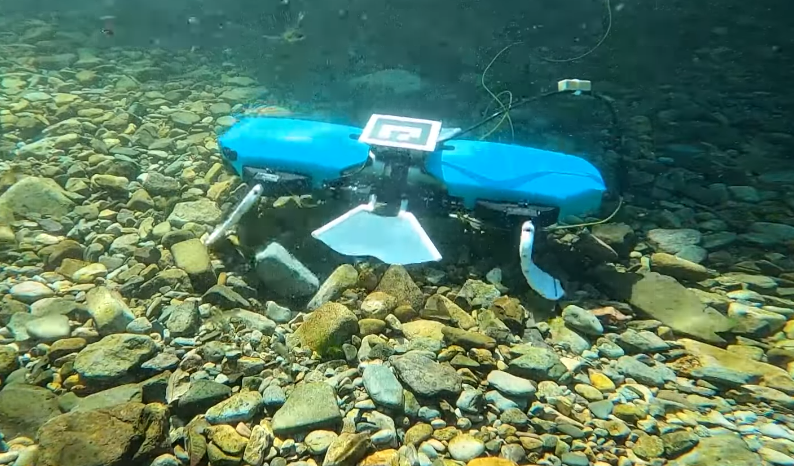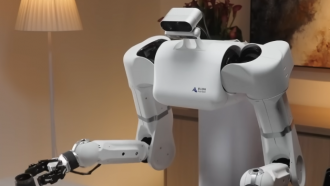There's a special robot that can explore underwater with ease-and it's not like any other machines you previously saw. The remarkable innovation known as "HERO-BLUE" is a new type of remotely operated vehicle (ROV) that promises to redefine the boundaries of marine research and robotic engineering.
It looks like a simple robot at first glance, but what it can do is beyond our understanding.
What is HERO-BLUE

(Photo : POSTECH HERO(Hazardous and Extreme Robotics) Lab on YouTube)
With HERO-BLUE now at the center of underwater discoveries, this not-so-common robot will impress you with its unique set of skills from the get-go.
Developed by Taesik Kim and his research team at South Korea's Pohang University of Science and Technology, HERO-BLUE stands out not just as a robotic vehicle but as a transformative approach to navigating underwater environments.
Officially known as the "Hazardous and Extreme Environment Robot for Biomimetic multiLocomotion-based Underwater Expedition," HERO-BLUE brings a new dimension to the exploration of the ocean's depths. Don't get fooled with its "aquatic" moniker since its capabilities are limitless.
HERO-BLUE measures an impressive 31.5 inches long, 23.6 inches wide, and 11.8 inches tall, weighing in at 24.9 pounds. The robot is remotely operated and boasts advanced stereoscopic vision, hinting at future capabilities for autonomous operations. This prototype robot has been featured in the esteemed journal IEEE Transactions on Robotics, highlighting its innovative design and capabilities.
Related Article: Penguin-Inspired Underwater Drone Gets a Boost: New Quadroin Offers Enhanced Performance
HERO-BLUE is Unlike Any Other ROVs
Unlike traditional ROVs that navigate with electric thrusters susceptible to debris and strong underwater currents, HERO-BLUE is engineered to overcome such limitations through its unique physical design.
What's more, the robot features four multimodal fins and two lateral fins made from polymer panels linked by elastomer tendons. This ingenious construction allows the fins to alternate between rigidity and flexibility, adapting HERO-BLUE's movement to different underwater conditions-whether flapping through the water like a fish or walking along the seabed to combat strong currents.
Innovative Locomotion Techniques
In shallower waters or areas where swimming may be ineffective, HERO-BLUE utilizes its salamander-inspired spine to maneuver, FoxNews writes. This flexible backbone enables the robot to wriggle forward, mimicking the movements of terrestrial and aquatic creatures to navigate through challenging environments efficiently. This means that this machine is not only limited to exploring the deepest of waters but it can also explore even the shallow parts of the oceans.
What's more, HERO-BLUE creators expect the robot to carry out more underwater missions, from scientific research to environmental monitoring and beyond. Its biomimetic design and ability to adapt to various aquatic scenarios equip it to handle tasks that traditional ROVs find challenging. This could include detailed ecological assessments, infrastructure inspections, and potentially, rescue operations in environments that are otherwise inaccessible to human divers and conventional underwater vehicles.
The Future of Marine Robotics
As we dive deeper into the mysteries of the ocean, technologies like HERO-BLUE are crucial in providing new insights and solutions. The robot's development represents an outstanding leap forward in ROV technology, setting a new standard for what is possible in marine exploration.
With its advanced capabilities and potential for autonomous operation, HERO-BLUE is not just a tool for today but a foundation for future innovations in underwater exploration.
We won't be surprised if exploring underwater sightings is not the only thing that this robot is capable of. In fact, this shape-shifting robot might be the key to discovering more species of animals in the depths of the oceans-where sunlight hardly reaches out.
In Antarctica, a group of researchers unlocked the sleeping secrets of the icy continent by deploying an underwater robot to its crevasses in the oceans.
Read Also: Boston Dynamics' New Atlas: Humanoid Robot Built to Fall and Get Back Up






